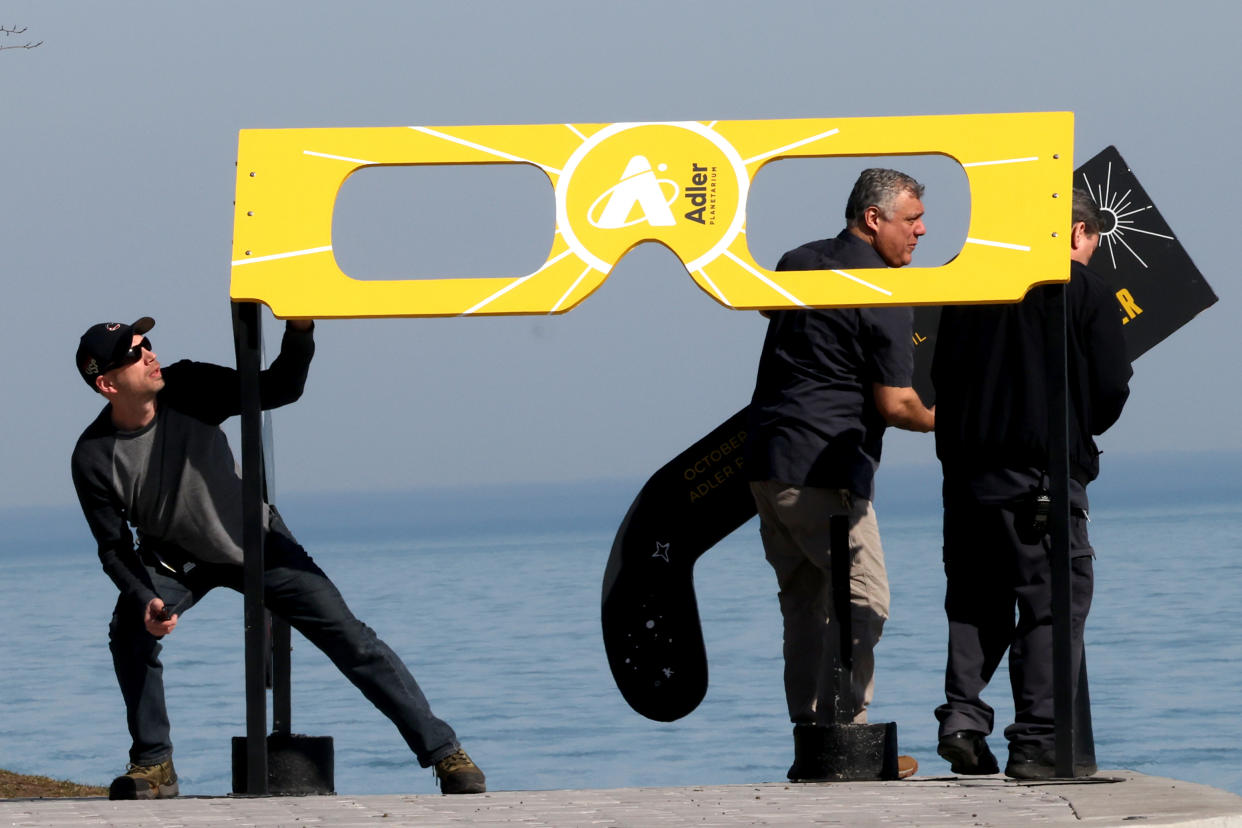Solar eclipse ‘a wonderful teaching moment’ for Chicagoans gathered at Adler, science museum

When Annemarie Catania heard her daughter’s school was planning to travel to the Adler Planetarium to see the solar eclipse, she immediately signed up to be a chaperone.
She sat outside the planetarium Monday in a crowd of thousands assembled along the building’s perimeter, watching the moon move in front of the sun.
“In 2017, I went outside and tried to see it with a colander,” Catania said. “It didn’t work. But now, looking at it straight on and seeing it so clearly with the glasses, it’s mesmerizing.”
Catania’s daughter was one of many students across Chicago who ventured out of their classrooms Monday to see the phenomenon. Just south of the planetarium, more than 1,000 Chicago Public Schools students crowded the rotunda at the Museum of Science and Industry, building rockets, learning to use telescopes and attempting to draw the sun’s outermost layer.
About 5,000 visitors were expected to gather to watch the solar eclipse at the Chicago museum, which hosted an official viewing in its courtyard. Inside, visitors watched a NASA livestream of the event in the Giant Dome Theater and participated in space-related activities throughout the day.
Kate Higbee, senior director of business development at the museum, said she started planning the event over a year ago.
“It’s one of those things that can really make an impact on your understanding of science and our solar system and the universe,” Higbee said. “It’s such a great opportunity that everyone should see, and it doesn’t take a lot to do.”
The moon blocked 94% of the sun in Chicago. As the eclipse neared its largest point of coverage, cheers erupted around the planetarium as the sky grew darker and the temperature dropped slightly.
After the sun came back out, Beebe Roh said the experience was even better than she had hoped.
“How can you beat this weather, this city, seeing all of this with the planetarium behind us?” Roh asked. “After seeing it, I want to know everything about the science behind it. It’s a wonderful teaching moment for my kids, but for me as well.”
Education on the event was central across Chicago. Carmen Mahon, curator of STEM programs at Chicago Public Schools, said an eclipse is the perfect opportunity to help students get excited and involved with science at an early age.
“I want them to take it all in,” Mahon said. “Remember that you’re a human, experience is learning and what we’re seeing can inspire pure joy.”
Related Articles
Science | Eclipse chasers head to southern Illinois for 2nd total solar eclipse in 7 years: ‘You get hooked’
Science | Solar eclipse: Glasses are key, but did you know clothing choice could enhance viewing?
Science | During next month’s solar eclipse, these scientists won’t be looking up
Science | Vintage Chicago Tribune: Solar eclipses and how Chicagoans viewed them
CPS partnered with the Museum of Science and Industry, and introduced activities to help the students there learn about the eclipse. Some drew, others learned by listening and some simulated the eclipse with physical stress balls.
Mahon said making students feel comfortable in the Hyde Park museum was one of her biggest goals for the day.
“I grew up on the South Side, and I didn’t feel a part of the museum growing up,” Mahon said. “Someone told me, ‘This is your museum, this is your South Side.’ And I thought, what if I could make sure all of the kids felt like that? This is where science happens and this is your museum.”
The museum also set up several “pop-up” viewing locations around the city for Chicago residents who could not make it to the museum or might not be able to pay the admission fee.
‘Like a holiday’: Thousands flock to eclipse crossroads in southern Illinois
Museum representatives were at Millennium Park, the Michigan Avenue Bridge, Oak Street Beach and the DuSable Black History Museum and Education Center with eclipse glasses and telescopes. Higbee said accessibility was a priority for the museum in organizing their coverage.
“One of the great things about an eclipse is that it’s a community experience,” Higbee said. “You stand with a bunch of other people, whether it’s your friends or your students, and you watch it happen together. I think everyone should have that.”
Lena Jessen said community was a big reason why she chose to watch the eclipse from the planetarium, surrounded by other Chicagoans.
“It’s a really cool thing to see,” Jessen said. “And it’s even cooler to see it surrounded by all of these people, who you know are just as interested as you are and are all looking at the same thing.”
Voula Saridakis, a curator at the Museum of Science and Industry and a NASA Solar System ambassador, said she hopes everyone who sees the eclipse leaves with an increased appreciation for the wonder of space, science and the universe.
“These are the most spectacular events to witness, and it’s a rarity,” Saridakis said. “It’s a rare event, it’s a beautiful event and I hope that everybody young and old gains that appreciation for the beauty of the universe and the heavens, and hopefully learns something new about science.”

